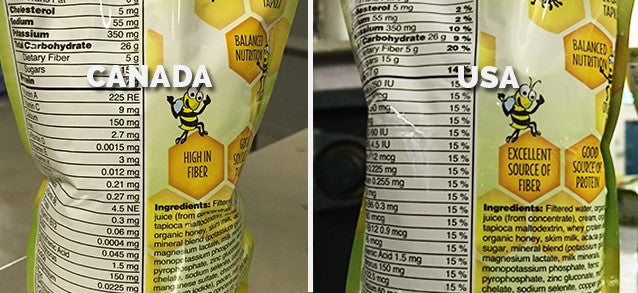Food Labelling Is Interesting Stuff


Ever wonder why the products you buy in Canada, look so different than their American counterparts? How can the exact same product have such different labels?? Sometimes labeling decisions are based on consumer market research which lead to variations in design to target specific demographics. However, just as often, the changes that you notice are due to labeling laws in the country of sale. As an example, we wanted to show you the back panel of a gnubees™ destined for sale in Canada (LEFT), and a gnubees™ destined for sale in the United States (RIGHT).
As you can see, the nutrition label is completely different and yet, the ingredients for both gnubees™ are completely identical. Obviously for those of us who don’t know the recommended micrograms of Thiamin off the top of our heads, the Canadian label is more confusing. So why not just have percentage daily values, as we do on our US label? Firstly, because we add vitamins and minerals to gnubees™, in Canada it needs to be called “Nutritional Supplement”. Furthermore, the labels of “Nutritional Supplements” are prohibited from using the Nutrition Facts table heading and the label must express the amounts of the nutrients in specific units but not as a percentage of the recommended daily intake. (CFIA Labelling Policy -more specifically Food and Drug regulations B.24.202.)
Long story short, Canadian law dictates that if you add vitamins to your product, you can’t use percentage daily values on the label. Huh? It may go without saying that we think this is completely nuts, because the result is a label which is more difficult for the average consumer to understand.
So it begs the question: “if the intention of nutrition labels is to provide consumers the information they need to make informed food choices, then why is the information on the label so confusing!!?” Good question. And if you have a problem with the rationale behind the answer, go here to ask your government officials for better labeling practices in Canada!


Leave a comment